Interbike Wrap-Up 2008

In many ways, Interbike signals the beginning of the new triathlon season, and the Ironman World Championships in Kona signals the end of the old. The ethereal and fleeting time between, known simply as the “two (or three) weeks between Interbike and Kona,” is a time for industry folks to unpack, wash, and repack their belongings, while Hawaii-bound athletes put the finishing touches on their tapers. For the rest of us, it represents a chance to ponder all those things that might help us make our way to the Big Island next year, without actually having to train any harder.
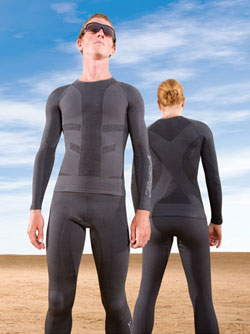
Unlike most good murder mysteries, I’ll begin my tales of Interbike with the climactic moment first. Every so often, I see something that I think really shows a company’s commitment to innovation. Usually, this item is something small, relatively inexpensive in the high-dollar world of triathlon, and something that would benefit pretty much everyone. At Interbike this year, it was Zoot’s CompressRx line of recovery and active compression gear. If you don’t actually believe in compression gear, please skip ahead to the word “carbon,” which I’m sure you’ll find somewhere in the following paragraphs. Personally, I am a big fan of compression gear both during and after exercise. Zoot’s new CompressRx line features eight items, with the two most appealing being the long-sleeve recovery top and the recovery tight. Unlike some companies, whose idea of compression is “tight clothing,” Zoot has done a lot of work to regionalize the compression to truly help you perform or recover more effectively. The recovery and active compression gear focus their compression in approximately opposite ways, with the recovery gear focusing the highest level on the belly of the muscle and the active gear putting the lowest level of compression in that spot, and each garment has a wide range of compression levels, each with a specific target. Zoot published a white-paper, which seemed quite well researched, on their approach to this new line. A dedicated review of the entire line-up is coming as part of our 2009 preview. But many kudos to Zoot for putting out an extremely well-thought out and useful product. They get my unofficial “Best in Show” award for 2008. In addition to the CompressRx gear, Zoot continues to expand their very popular shoe line, adding two new trainers for 2009. As much as advanced recovery gear may get me excited, it probably isn’t the thing most triathletes think of when they ponder what they need to do their first sprint triathlon. To help those folks out, Zoot is introducing two entry-level wetsuits to complement their high-end suits.
XTerra, on the other hand, is tweaking the top of their wetsuit range for 2009. In what seems to be a growing trend, XTerra will be releasing a new suit for next year with #40 Yamamoto neoprene for the arms and shoulders with a body made of the slightly less stretchy (and slightly more durable) #39 rubber. This dual-rubber design is already proven on 2XU’s Velocity V:1 and blueseventy’s 2008 Helix. Given that the best part of the XTerra’s all-#40 Vendetta was it’s sleeves and the best part of their all-#39 Vector Pro X2 was it’s fit through the body, I think the new suit will be a winner. XTerra superstud Conrad Stoltz who happens to be sponsored by the eponymous wetsuit company stopped by to pick up a new Velocity speedsuit for his title defense in Maui. I think Conrad is pretty cool, especially his farm-chore training routine at home in Stellenbosch, so while he doesn’t actually lend anything else to the article, I just thought I’d mention it.
Overhauling their entire wetsuit line was triathlon pioneer Quintana Roo. After a somewhat unfortunate two-year period where QR experimented with new patterns and suits made entirely of #40 rubber, they are returning to the familiar “V” shaped patterns developed by QR founder Dan Empfield. Jumping onto the dual-rubber train, these suits will feature #40 rubber in the sleeves and #39 rubber in the bodies, where the fit of the previous generation of suits fit rather poorly. There are also several panels that feature the “ribbed” rubber that made the original Superfull one of the most popular suits in the history of the sport. If these suits can capture the feel of the originals, QR should be poised to take back a chunk of the market that it created oh so many years ago. In addition to their fancy new wetsuits, which QR looked to improve by checking the history books, they also had a new tribike on display which was designed by throwing away everything that convention dictated about how a bike should be built. The new Cd0.1, so named for the drag coefficient the bike generated during windtunnel testing, features an off-center downtube designed to shunt air away from the drivetrain side of the bike, thus minimizing the drag due to the bikes crankset, derailleurs, casette, and chain. While this was the real showstopping feature of the bike, it also featured some well thought out additions like an angled track for the saddle clamp that automatically adjusts for the required increase in saddle height that accompanies steepening the effective seat-tube angle. So if you have your saddle height set at 78deg, you can just slide the clamp forward in the slot and the slight angling will keep your saddle height the same. Furthering American Bicycle Group’s aim of keeping Litespeed as a titanium-only brand, there was also a new carbon fiber road bike on display bearing the QR marquee. Given that many triathletes split their training time between their race bike and a road bike, this may appeal to the legions of folks who insist on wearing a finisher’s t-shirt every day as yet another way to proclaim to the world that, “Yes, I am a triathlete.”
Revamping not only their wetsuits, but their entire clothing line as well, is perennial triathlon namebadge Orca. After losing out badly to upstart-turned-powerhouse 2XU in the past couple years, Orca is looking to reassert it’s place in the market with a top-to-bottom makeover. Orca’s bucks the trend to use a combination of rubbers in it’s new top-of-the-line Alpha wetsuit, which is made entirely of #40 rubber, including relocated panels made of Orca’s AirLite neoprene. Orca has made so many changes that we’ll be covering the entirely new lineup as part of our 2009 preview. Personally, I think this upcoming year will be a crucial one for Orca. If wholesale changes to their entire lineup can’t reestablish this brand, I think Orca may continue to fade into obscurity, with 2XU firmly established atop the triathlon apparel world.
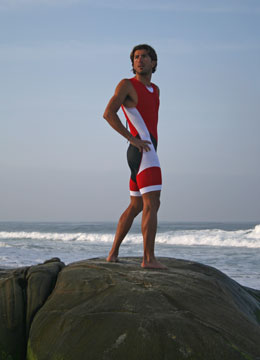
Amongst the smaller apparel brands in the sport, no company enjoys more fierce loyalty among the denizens of Slowtwitch than De Soto. One of the original brands in the sport, De Soto has been around longer than many of today’s young gun pro athletes have been alive. Leaving their extremely popular two-piece T1 Wetsuits alone for 2009, Emilio De Soto still had a few new items to show off. A proponent of compression gear since the early days of DuPont’s “PowerLycra,” which De Soto features on their Forza line of clothing, De Soto was showing off their new calf compression sleeves, available in gray and black. Their other new product for 2009 is a new trisuit, designed to fit the ITU’s uniform requirements, which will also affect age-group athletes starting in the new year. The suit conforms to the ITU’s paneling requirements for logo placement, and also features a 12inch (30cm) back zipper with leash. Typical of this think-outside-the-box company, the suit also features a buoyant pad, which works to help lift the hips, while still meeting the ITU’s restrictions on flotation. The suit takes the best elements of their classic Forza trisuit and blends them with the superior cut of the Liftfoil suit. This suit is a definite winner and will be the focus of it’s own review for 2009. Having worn it for a few workouts, I can definitely say it’s the best suit I’ve worn of De Soto’s.
Rounding out my review of softgoods is a rather unique item from hydration specialist Camelbak. The Racerbak is a mesh tank-top with Camelbak’s well-known bladder system embedded in the back. Designed for time-trialists, Camelbak disclosed that they are working on a triathlon-specific version for sprint and Olympic distance triathletes looking to squeeze every last second out of their bike split. The goal of the triathlon-specific Racerbak will be something that is wearable for the whole race, with a clear focus, however, on the cycling portion. With a proven pedigree in time-trialing, I’ll be interested to see what they can come up with for multisport. In addition to this vaporware, Camelbak did have a ready-for-production addition to their lineup of Podium waterbottles, which I think are the best around. The new ChillJacket insulated bottle incorporates a lightweight, flexible insulating liner into the bottle to keep your cold (or hot) beverages at temperature. I’ve been toting mine around since the show, and there was still ice in the bottle after leaving it in the hot car while I went for an hour run, one of many how-cool-can-you-keep-it tests I’ve been informally conducting while training. Insulated bottles are a lifesaver when the weather becomes a challenge, and I think Camelbak is going to give a real challenge to the Polar Bottle, which is the only other squeezable insulated bottle I know of.
Moving over to hardgoods, Specialized confirmed that they would finally make their highly coveted TT02 time-trial helmet available to the public. Though CPSC-certified from the beginning, Specialized had restricted this lid to its sponsored professional triathletes and cyclists. While varying from individual to individual, the TT02 has a large number of solid performances in triathlon, time-trial, and the windtunnel behind it. Specialized would not confirm whether or not the short-tailed TT03, worn by Cadel Evans during the 2008 Tour de France, would be made available as well, but one would hope so. I pointed out that releasing both helmets would make Specialized the only company to truly cater to different rider positions and morphologies, so I’m hopeful that will be the case. The TT02 is making its retail debut in Kona, so I’ll be anxious to hear how many racers make a last minute switch to the helmet that protected Chris McCormack en route to victory in 2007.
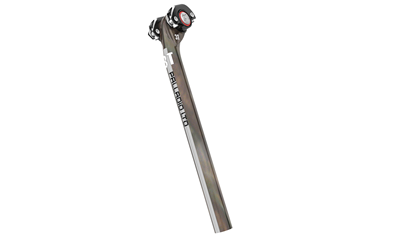
Aero continues to be the name of the game for component makers. Recently risen phoenix 3T (aka “The New 3T”) showed off their modular clip-on//base-bar//plug-in-brake aerobar, the Brezza. 3T is taking over as the new components supplier to the Garmin-Chipotle team, ousting Oval Concepts, and the Brezza was a necessity for this deal, as the boys in argyle could not ride 3T’s signature Ventus aerobar aboard their integrated-front-end Felt DAs. The Ventus will be the aerobar of choice for the new Cervelo Test Team, giving 3T a pair of potential grand tour powerhouses for the upcoming season. In addition the attention-grabbing aerobars, 3T also quietly debuted a new seatpost – the Palladio – with the potential to make a huge splash as an OEM component. The seatpost features a round splined cylinder. The inner section of the cylinder has 40 teeth, meaning that each incremental change changes your saddle pitch by 9degrees. The outside clamps sit on 42-tooth splines, or an 8.5degree pitch, giving you roughly half of a degree of pitch control by rotating the inner spline and outer clamps in opposite directions. Once it is tight, there is no way for the saddle to slip, at least barring major catastrophe. The system is easily adaptable to any number of popular seatpost designs, and it lends itself especially well to large aspect-ratio aero seatposts where fore-aft bolts are an impossibility. The most immediate candidate for the new hardware has to be Cervelo, given both its close relationship with 3T and the potential for improvement of the current clamping system used on the P4, P3C, and P2C.
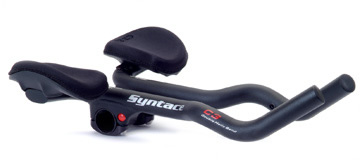
Also showing off new clip-on aerobars was triathlon stalwart Syntace. Once the aerobar of choice for much of the triathlon world, Syntace occupied a small and quiet booth where many people walked by their new C3 clip on without taking so much as a second look. Exceedingly practical, Syntace’s Joe Klieber will never do something simply to follow trends. Unfortunately, it seems that he also won’t do something simple to boost sales. The C3 clip-on is an aluminum clip-on, and while that isn’t something that is inherently a detraction, it does lessen the “sex appeal” of Syntace’s products to the average consumer. Sitting as it does atop the glorious and sexy Stratos base bar, which is a fantastic testament to what Syntace can make out of carbon when they want to, the C3 looks even more humble. As I like to do with most things that aren’t behind glass, I put my hands all over these bars and became even more frustrated. Syntace’s unique “Double Helix” bend is one of the most comfortable I’ve ever felt. Like the Blackwell WristRelief shape, the C3 takes the long and curvy road to get from A-to-B. Syntace makes some profound claims about how holding these bars will improve the aerodynamics of your back, but all I really cared about was how natural it felt to hold them. Unfortunately, as with all Syntace products, if you want these extensions, you have to take the pads and clamping mechanism that come permanently attached to them. I pondered whether or not a strategically implemented hacksaw might provide me with a set of modular extensions, since the folks at Syntace do not seem eager to play nice with the rest of the triathlon world by releasing the extensions alone in a 22.2mm diameter. The bars themselves come in Small, Medium, and Large, which I find inconvenient for buying and retailers find inconvenient for stocking, but which do offer pretty much as wide a range of fit as you could want. Syntace bars are also extremely high in stack, making them a great option for those people who aspire to ride any of the current bikes with miniscule headtubes yet who do not possess the athleticism to position themselves aboard said bikes like the Dave Zabriskies or Normann Stadlers of the world for whom they were designed. This high stack also means that you can conveniently slot your hands underneath the aerobar pads and atop the very comfortable base bar for a very nice hands-on-the-tops position that would be a welcome relief on a long climb like Ironman Canada’s Richter Pass. These bars probably ought to find their way onto many more bikes than they will.
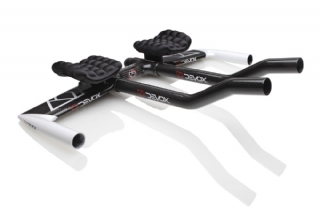
Formally unveiling their new aerobar was bike maker Felt with their new line-up of Devox components. Already boasting a bronze medal at the UCI World Time Trial Championships, the Devox aerobar is designed to be as modular as possible, with a flippable base bar, a wide range of extensions, and a large assortment of shims for setting pad height. The aerobar is the marquee item among a lineup of stems, handlebars, and the usual that sees Felt moving more closer to a complete in-house line-up of hardgoods. Michellie Jones’s 2009 Felt DA was kitted out with these new aerobars, which drew plenty of attention to the new Bayonet front end that Felt is debuting for 2009. The new Bayonet offers a whopping 2.2cm of reduction in stack height, as well as offering a few degree of rotational adjustment to allow the end user to offset any minor imperfections in the alignment of the fork and stem. The new system also shaves off over 100g in total weight, as well as being a much simpler system to build up. Felt also will offer it’s integrated stems in 31.8mm diameter for the first time, allowing riders access to an even wider selection of aerobars.
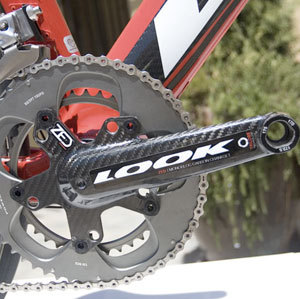
Making more radical overhauls to their marquee bikes was French manufacturer LOOK. LOOK’s new 576 triathlon bike is a testament to their renewed interest in triathlon. Centered around a 78.5 degree seat-tube angle, with the complete bike geometry to match, the 576 is a great mid-range bike for any triathlete. Unfortunately, the 576 is overshadowed by the high-flash, high-dollar 596, which is the product of extensive windtunnel development and overall clever thinking. Due to the unique integrated front end, it was not clear to me how the bike was supposed to fit. Was it, or was it not, designed to be ridden steep? This question, surprisingly, stumped not only the LOOK engineers at the show, but also the team back in France. Further proving my belief that LOOK is serious about triathlon, they admitted that it was a problem that they could not answer this question, and promised that they would reduce their already overly long vacations (okay, I made that part up) and figure out an answer. Depending on what they come back with, I may or may not like the 596 as a bike a lot more or a lot less. But regardless, I think LOOK has the smarts to make an impact in the market going forward, that is assuming they realize that making bikes that French people want to buy is a lot less intelligent than making bikes that the rest of the triathlon world wants to buy. One incontrovertibly excellent feature of the 596 is its ZED crankset. This integrated crankset features drillings for 130mm (standard) or 110mm (compact) bolt patterns as well as an eccentrically lobed insert that mates with a special pair of KEO pedals to allow the rider to ride 170mm, 172.5mm, or 175mm crankarms. Crankarm length is probably the subject of more black magic and voodoo style articles than any other subject in the sport of cycling. People probably ought to experiment with different length cranks more than they do, but the cost of doing so is prohibitive. With LOOK’s system, you are not wedded to any one cranklength (though you are wedded to their system), which I think opens the door to experimentation without a lot of hassle. Though underemphasized, I think this was the most interesting feature on the bike, and the one that I would most like to see make it’s way into more of their frames.

Ubiquitous at the show, with probably ten times as many wheels on display outside of their booth as within, was Zipp. Unique to the Zipp booth, however, were wheels featuring their new hubset, which replaces the carbon fiber dustcaps of old with a new preload adjuster and aluminum dustcap which can be color coordinated with your decals through Zipp’s SpeedShop program. Not entirely new, but rather updated and improved for 2009, are the venerable 404 and 808 tubulars, which receive the benefit of trickle-down engineering from Zipp’s ultra-deep 1080. The clincher wheels, due to the unique aerodynamic challenges presented by a clincher rim, remain unchanged. Zipp also had a brand new 100g stem that features not a single piece of integrated metal any where on the stem. The titanium hardware (one bolt for the steerer, and two for the faceplate) is entirely removable and replaceable. This new stem makes a dashing combination when paired with any of their three road bars, each of which is available in three different bend configurations. Zipp continues to push the envelope on their molded carbon parts, with the SRAM-compatible of their VukaShift aerobar extensions, which allow the shifter body to mount directly to the extension, finally being released to the public.
I saw a lot of other things at Interbike, but not too much else that caught my fancy. It’s an impossibly large show, and the number of gems is vastly outweighed by the companies pitching more of the same. I was lucky enough to find a couple items that are hopefully worth pursuing further for standalone articles about what’s new to buy in 2009, assuming that the economy is still in any sort of shape to support us. Until next year, thankfully, that’s another Interbike in the bag.

